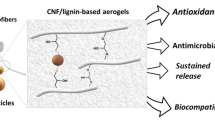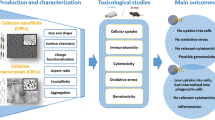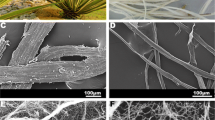Abstract
Cellulose nanofibrils based on wood pulp fibres are most promising for biomedical applications. Bacterial cellulose has been suggested for some medical applications and is presently used as wound dressing. However, cost-efficient processes for mass production of bacterial cellulose are lacking. Hence, fibrillation of cellulose wood fibres is most interesting, as the cellulose nanofibrils can efficiently be produced in large quantities. However, the utilization of cellulose nanofibrils from wood requires a thorough verification of its biocompatibility, especially with fibroblast cells which are important in regenerative tissue and particularly in wound healing. The cellulose nanofibril structures used in this study were based on Eucalyptus and Pinus radiata pulp fibres. The nanofibrillated materials were manufactured using a homogenizer without pre-treatment and with 2,2,6,6-tetramethylpiperidine-1-oxy radical as pre-treatment, thus yielding nanofibrils low and high level of anionic charge, respectively. From these materials, two types of nanofibril-based structures were formed; (1) thin and dense structures and (2) open and porous structures. Cytotoxicity tests were applied on the samples, which demonstrated that the nanofibrils do not exert acute toxic phenomena on the tested fibroblast cells (3T3 cells). The cell membrane, cell mitochondrial activity and the DNA proliferation remained unchanged during the tests, which involved direct and indirect contact between the nano-structured materials and the 3T3 cells. Some samples were modified using the crosslinking agent polyethyleneimine (PEI) or the surfactant cetyl trimethylammonium bromide (CTAB). The sample modified with CTAB showed a clear toxic behaviour, having negative effects on cell survival, viability and proliferation. CTAB is an antimicrobial component, and thus this result was as expected. The sample crosslinked with PEI also had a significant reduction in cell viability indicating a reduction in DNA proliferation. We conclude that the neat cellulose nanostructured materials tested in this study are not toxic against fibroblasts cells. This is most important as nano-structured materials based on nanofibrils from wood pulp fibres are promising as substrate for regenerative medicine and wound healing.






Similar content being viewed by others
References
Abe K, Iwamoto S, Yano H (2007) Obtaining cellulose nanofibers with a uniform width of 15 nm from wood. Biomacromolecules 8(10):3276–3278
Borenfreund E, Puerner J (1985) Toxicity determined in vitro by morphological alterations and neutral red absorption. Toxicol Lett 24:119–124
Chinga-Carrasco G (2011) Cellulose fibres, nanofibrils and microfibrils: the morphological sequence of MFC components from a plant physiology and fibre technology point of view. Nanoscale Res Lett 6:417
Chinga-Carrasco G, Syverud K (2012) On the structure and oxygen transmission rate of biodegradable cellulose nanobarriers. Nanoscale Res Lett 7:192
Chinga-Carrasco G, Yu Y, Diserud O (2011) Quantitative electron microscopy of cellulose nanofibril structures from Eucalyptus and Pinus radiata kraft pulp fibres. Microsc Microanal 17:563–571
Dong S, Hirani AA, Colacino KR, Lee YW, Roman M (2012) Cytotoxicity and cellular uptake of cellulose nanocrystals. Nano Life 2(3):1241006
Heijnes-Son-Hultén A (2007) Method for preparing microfibrillar polysaccharide. Patent no. WO 2007/001229 A1
Lanone S, Rogerieux F, Geys J, Dupont A, Maillot-Marechal E, Boczkowski J, Lacroix G, Hoet P (2009) Comparative toxicity of 24 manufactured nanoparticles in human alveolar epithelial and macrophage cell lines. Part Fibre Toxicol 6:14
Moreira S, Silva NB, Almeida-Lima J, Rocha HAO, Medeiros SRB, Alves C, Gama FM (2009) BC nanofibres: in vitro study of genotoxicity and cell proliferation. Toxicol Lett 189:235–241
Pääkkö M, Ankefors M, Kosonen H, Nykänen A, Ahola S, Österberg M, Ruokolainen J, Laine J, Larsson PT, Ikkala O, Lindström T (2007) Enzymatic hydrolysis combined with mechanical shearing and high-pressure homogenization for nanoscale cellulose fibrils and strong gels. Biomacromolecules 8:1934–1941
Park MVDZ, Lankveld DPK, van Loveren H, de Jong WH (2009) The status of in vitro toxicity studies in the risk assessment of nanomaterials. Nanomedicine 4(6):669–685
Saito T, Nishiyama Y, Putaux JL, Vignon M, Isogai A (2006) Homogeneous suspensions of individualized microfibrils from TEMPO-catalyzed oxidation of native cellulose. Biomacromolecules 7(6):1687–1691
Salem AK, Stevens R, Pearson RG, Davies MC, Tendler SJB, Roberts CJ, Williams PM, Shakesheff KM (2002) Interactions of 3T3 fibroblasts and endothelial cells with defined pore features. J Biol Mater Res 61(2):212–217
Sayes CM, Reed KL, Warheit DB (2007) Assessing toxicity of fine and nanoparticles: comparing in vitro measurements to in vivo pulmonary toxicity profiles. Toxicol Sci 97:163–180
Syverud K, Xhanari K, Chinga-Carrasco G, Yu Y, Stenius P (2010) Films made of cellulose nanofibrils—surface modification by adsorption of a cationic surfactant and characterisation by computer-assisted electron microscopy. J Nanopart Res 13(2):773–782
Syverud K, Chinga-Carrasco G, Toledo J, Toledo PG (2011a) A comparative study of Eucalyptus and Pinus radiata pulp fibres as raw materials for production of cellulose nanofibrils. Carbohydr Polym 84:1033–1038
Syverud K, Kirsebom H, Hajizadeh S, Chinga-Carrasco G (2011b) Cross-linking cellulose nanofibrils for potential elastic cryo-structured gels. Nanoscale Res Lett 6:626
Turbak AF, Snyder FW, Sandberg KR (1983) Microfibrillated cellulose, a new cellulose product: properties, uses, and commercial potential. J Appl Polym Sci Appl Polym Symp 37:815–827
Vartiainen J, Pöhler T, Sirola K, Pylkkänen L, Alenius H, Hokkinen J, Tapper U, Lahtinen P, Kapanen A, Putkisto K, Hiekkataipale P, Eronen P, Ruokolainen J, Laukkanen A (2011) Health and environmental safety aspects of friction grinding and spray drying of microfibrillated cellulose. Cellulose 18:775–786
Vishwakarma V, Samal SS, Manoharan N (2010) Safety and risk associated with nanoparticles—a review. J Miner Mater Charact Eng 9(5):455–459
Wang J, Kim SC, Pui DYH (2008) Investigation of the figure of merit for filters with a single nanofiber layer on a substrate. Aerosol Sci 39:323–334
Zimmermann T, Bordeanu N, Strub E (2010) Properties of nanofibrillated cellulose from different raw materials and its reinforcement potential. Carbohydr Polym 79(4):1086–1093
Acknowledgments
The work was financed by the Research Council of Norway through the Grant 196119/V30.
Author information
Authors and Affiliations
Corresponding author
Rights and permissions
About this article
Cite this article
Alexandrescu, L., Syverud, K., Gatti, A. et al. Cytotoxicity tests of cellulose nanofibril-based structures. Cellulose 20, 1765–1775 (2013). https://doi.org/10.1007/s10570-013-9948-9
Received:
Accepted:
Published:
Issue Date:
DOI: https://doi.org/10.1007/s10570-013-9948-9




